Congratulations to all of the 2023 Design Pittsburgh award winners and thank you to all of the firms that submitted projects this year!
SMALL: Certificate of Merit
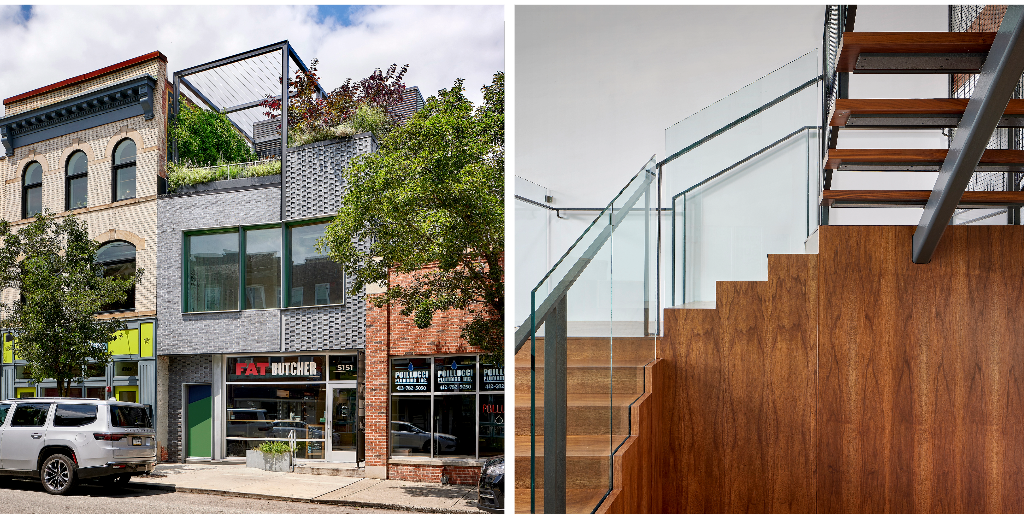
Flemish51 on Butler
Project Team: Andrew Moss, AIA; Katie Seftas; Katie LaForest; Kellie Locke
Client: 5151 Butler LLC
Contractor: Essig Renovation & Design, Dan Essig – Contractor
Engineers: Gateway Engineers, John Schneider – Structural Engineer; WNA Engineering, Tony Valenza – MEP Engineer
Photographer: Ed Massery
Landscape Architect: Ground Stories Landscape Architecture, Julie Kachniasz – Landscape Architect
Situated along a busy commercial avenue of Butler Street in Pittsburgh’s upper Lawrenceville neighborhood, Flemish51 on Butler is an urban infill project that renovates a defunct, out-of-character, existing building. The design strategy for the project began with a careful analysis and understanding of the neighboring historic streetscape. The 3,334 SF building stitches together the traditional 3-story building facades that make up much of the commercial artery. The renovation aimed to revitalize the ground level street presence for a retail space, setting the building back to allow for accessibility. A new addition at the rear created an opportunity for a double-height interior space at the second floor with mezzanine and roof deck overlooking Butler Street.
JURY COMMENTS: “Flemish 51 successfully integrates modern design elements into a historic streetscape. The design approach develops a relationship between the old and new, using a steel structure to imply a third story that is home to a rooftop patio. Sophisticated brickwork along with the introduction of greenery creates a stunning facade and the attention to the interior details of the wooden stair is commendable. An excellent example of infill urbanism.”
SMALL: Certificate of Merit
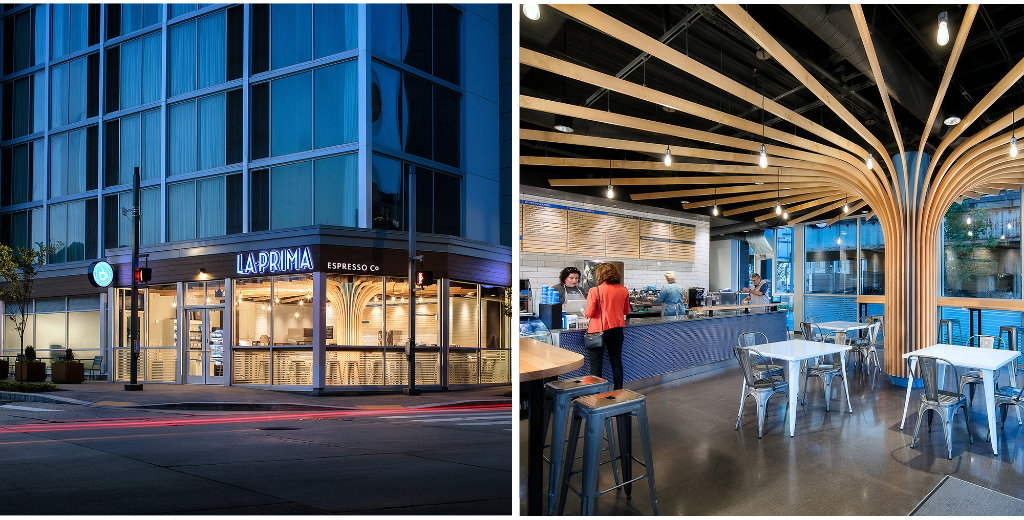
La Prima Espresso
Architecture Firm: DLA+ Architecture & Interior Design
Project Team: Nick Doichev, AIA; Dennis Astorino, AIA; Geoffrey Lester, AIA; Chris Chiusano, CSI, CCCA, CDT
Client: La Prima Espresso
Contractor: Avanti Design + Build, Jim Roberts – Contractor
Engineers: Pedicone Engineering Consultants, Guy Pedicone – Mechanical Engineer; WNA Engineering, Inc., Chris DiCianna – Electrical Engineer
La Prima engaged our design team to create its new coffee house located in the AC Marriott in Downtown Pittsburgh. An existing structural column that supports the hotel presented a unique design challenge, as it is located in the customer space. Now clad with a dynamic array of wood slats radiating along the ceiling, the column evokes a coffee tree, creating a modern focal point that energizes the space and not only supports the hotel, but also those who use the café. The project sustains a legacy brand while updating and expanding the expression of that brand in a unique coffee house experience.
JURY COMMENTS: “A simple, but clever wooden intervention that creates a lot of impact with limited scope. The design improves visibility for the cafe by embracing a pesky existing condition rather than simply masking it. The jury appreciated the playful yet well executed design that has a strong visual impact from the street.”
SMALL: Certificate of Merit
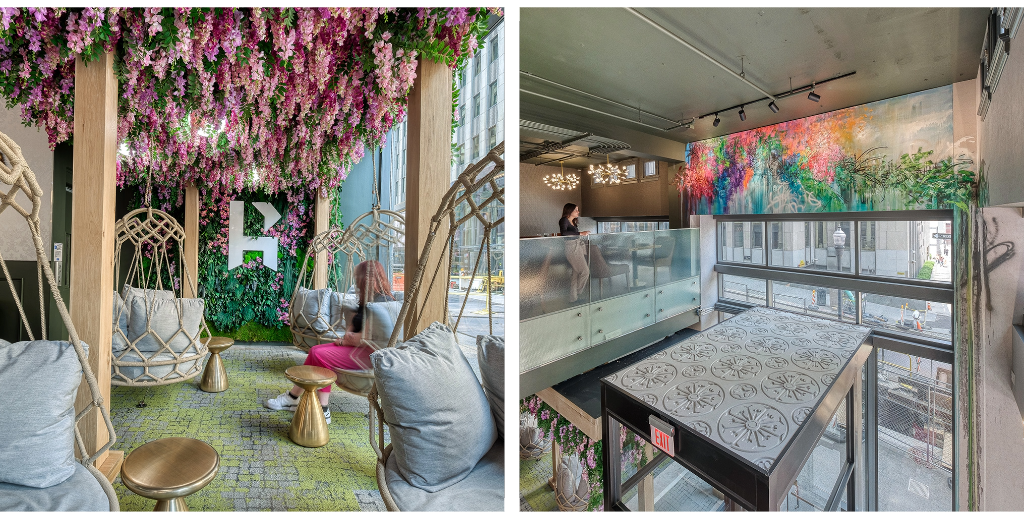
Ritual House
Architecture Firm: NEXT architecture
Project Team: Dan Delisio, AIA; Tracy Delisio, NCIDQ; Taylor Schaffron, NCIDQ
Client: Herky and Lisa Pollock
Photographer: Mike Leonardi
The design intent for this project was to design an eclectic and memorable restaurant. The owner wanted a space that is versatile and welcomes the brunch, lunch and dinner crowds. This restaurant’s goal is honor life’s rituals through food and atmosphere. The design celebrates both physical and spiritual rituals that people practice on a daily basis. With different design elements throughout the space, you will have a different experience every time you visit.
JURY COMMENTS: “The maximalist, fantastical approach to the design of Ritual House intrigued the jury. The strong concepts carried through the spatial zones create multiple levels of experience for patrons that do not disappoint. Blending design elements from various time periods creates a funky, charming, and colorful experience. The sum of these eclectic design decisions ensures an authentic and memorable dining experience.”
MEDIUM: Certificate of Merit
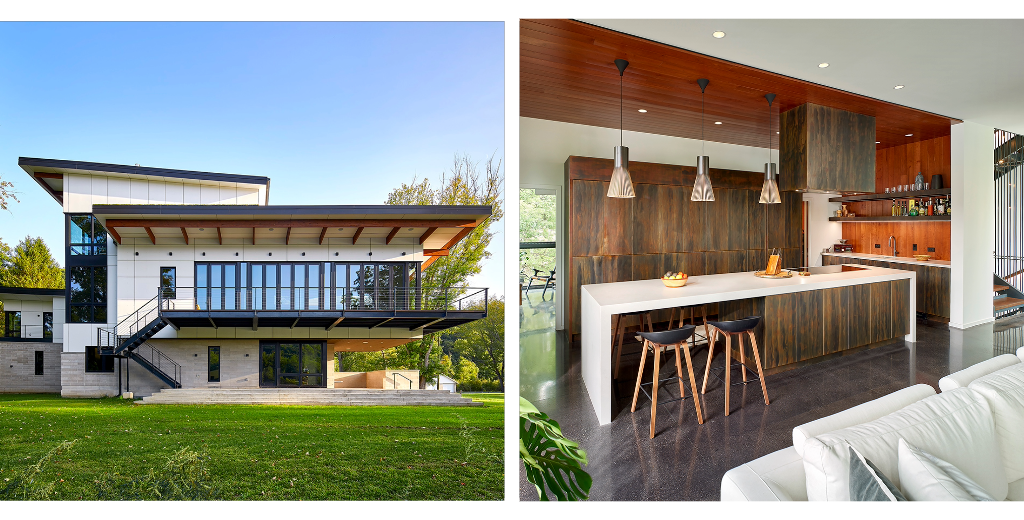
Godfrey Landing Residence
Architecture Firm: mossArchitects
Project Team: Andrew Moss, AIA; Katie Seftas; Gina Konopack; Annie DeArmit; Anna Foster; Nathaniel Rice
Contractor: Martik Brothers Inc, Trace Martik – General Contractor;
Engineers: Schneider Engineering, John Schneider – Structural Engineer; Fortier Engineering, Dan Fortier – MEP Engineer
Photographer: Ed Massery Photography
The Godfrey Landing Residence was designed to embrace its surrounding riverfront landscape, with an emphasis on sustainability and flexibility. The design accommodates both living and working, and adaptability for multi-generational occupants. The concept originates from river barges that historically were common along this stretch of the Allegheny River in Gilpin Township, Pennsylvania. The house is organized as two resting “barges” that are interconnected by the home’s entrance and grand staircase.
JURY COMMENTS: “The organizational parti of Godfrey Landing successfully responds to the unique conditions of a residence adjacent to a waterway and within a floodplain. This parti operates in both plan, through the separation of the public from private spaces, and in section, by lifting the primary living spaces above the floodplain The thoughtful approach to the site illustrates the design team’s understanding of building resilience, building on a remote site and high-performance mechanical systems. Further, the design has structurally challenging elements that blur the interior/exterior living spaces and further emphasize the spatial and tectonic separation of the house from the ground.”
MEDIUM: Certificate of Merit
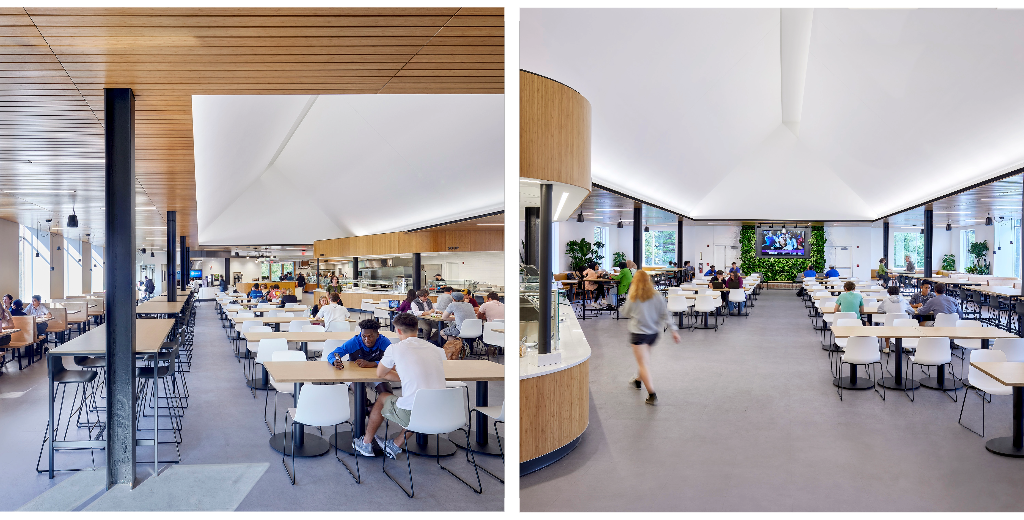
Chatham Anderson Dining Hall
Architecture Firm: Rothschild Doyno Collaborative
Project Team: Ken Doyno, AIA; Kate Tunney, AICP; Drew Mosher, AIA; Eli Gutierrez, AIA; Nickie Cheung, AIA; Jeff Kalina, Associate AIA; Tara Earnest, Assoc. AIA; Bryan Thompson, AIA; Daniel Rothschild, FAIA; Kim Rullo; Chinaza Okafor; Chic Noll
Client: Chatham University
Contractor: Mosites Construction, Mark Edgar – General Contractor
Engineers: Atlantic Engineering Services, Bob Bertocchi – Structural Engineering; Iams Consulting, LLC, Jonathan Iams – MEP Engineering
Photographer: Ed Massery/Massery Photography
Consultants: hD5 Hospitality Design, Evan Felps – Kitchen Design Consultant
The dining hall is a key center for social and nutritional sustenance, supporting mental health and physical health for the university community. Anderson Dining Hall was an outdated facility comprised of separate rooms. The transformation creates a connected, uplifting, bright, and environmentally expressive student experience reflecting Chatham University’s bucolic arboretum campus.
Working within the existing building envelope, the reconfigured spaces become an open and connected environment with the curvilinear servery fostering a natural circulation flow to the dining facility. A sculptural central ceiling form elevates the atmosphere of the dining area with indirect lighting calibrated to reflect the circadian color temperatures of the day, reinforcing the connection to nature, health, and well-being.
New windows along each facade bring natural light and views to campus. Perimeter planters, green “hearth” walls, and wood bring the beauty of the arboretum campus indoors.
JURY COMMENTS: “Chatham Dining Hall is effectively transformed by the introduction of a faux skylight. The impact of this one element is astounding and its contrast with the wooden ceiling and raw steel columns generates an elegant composition. Restraint and consistency in the surrounding interior elements create a soft, yet warm, space for students to enjoy.”
MEDIUM: Honor Award

Willkommen on Vine
Architecture Firm: GBBN
Project Team: Chad Burke, AIA; Mary Jo Minerich; Blaise Durio, AIA; Amanda Markovic, AIA; Chas Wiederhold; Doug Richards, FAIA; Steve Kenat, AIA; Anne Chen, AIA
Client: Model Group
Contractor: Model Construction, Brian Ross – Contractor
Engineers: Engineered Building Systems, Brandon Olson – MEP Engineer; Bayer Becker, Mike Dooley – Civil Engineer; Schaefer, Doug Steimle – Structural Engineer
Photographer: Ryan Kurtz Photography
Consultants: Sol Design Consulting, Sanyog Rathod – LEED Consultant
Dedicated to the principle that there is no conflict between affordability, historic preservation, and quality design, Willkommen on Vine delivers equity to a population that is often excluded from the dignity, functionality, and delight of good design.
Part of the largest addition of affordable housing in Cincinnati’s Over-the-Rhine district in decades, the building strikes up a playful dialogue with its historic context. Slipping into a surface lot (a legacy of economic disinvestment), the building reinforces the density, vibrancy, and commercial activity that make its neighborhood great.
Celebrated for its striking brick geometry—a modern take on its neighbor’s historic oriels—its undulating façade floats above a glass storefront, providing privacy and letting in daylight for residents while enriching the street life below. A marriage of craft and technology—the mason’s hand + AR goggles—this distinctly contemporary feature helps residents appreciate the ongoing and dynamic history of Over-the-Rhine.
JURY COMMENTS: “There is a timeless quality to the facade that utilizes new technologies and brick coursing research to create an elegant interpretation of a classic design element: the bay window. The articulation of the thickened windows in the facade improve access to daylight without compromising privacy for residents. The jury was moved by the dedication of the design team to elevate the face of affordable housing; they clearly understood the historical significance of the surrounding context to create an elegant design solution that creates desirable housing for all. This project is a showcase of the positive impact excellent design can have on affordable housing.”
MEDIUM: Honor Award
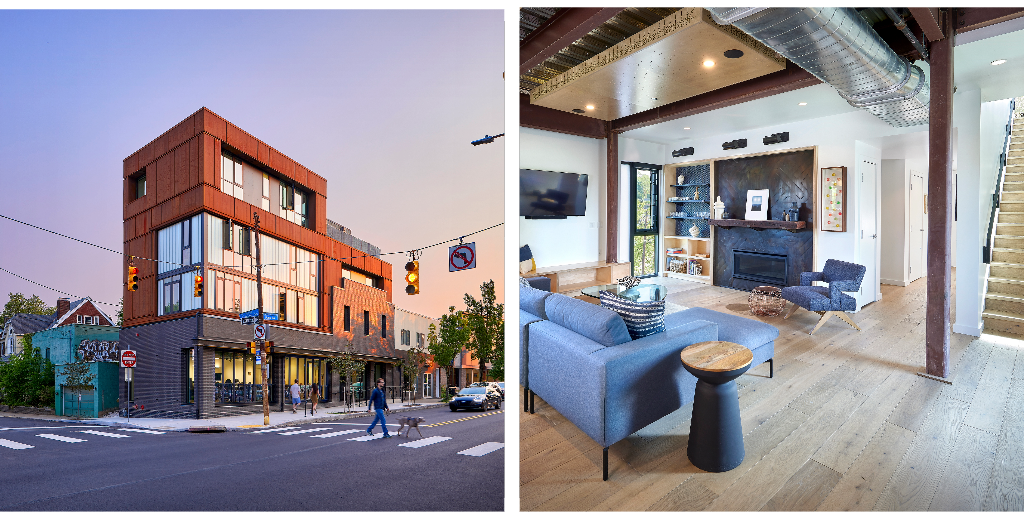
Penn Atlantic Building
Architecture Firm: mossArchitects
Project Team: Andrew Moss, AIA; Darren Lloyd; Jim Bischoff; Gina Konopack; David Teufel; Dylan Stein; Heather Michael Grew; Arthur Notaro; Alyssa Hamilton
Client: Pedantic LLC
Contractor: Sota Construction Services, Philip Ford – Contractor;
Engineers: Gateway Engineers, John Schneider – Structural Engineer; WNA Engineering, Tony Valenza – MEP & Fire Protection Engineer; Gateway Engineers, Sean Donnelly – Civil Engineer
Photographer: Ed Massery Photography
Consultants: Monmade, Katie Schaible – Local Artisan Consultant
Designed for a prominent corner along the Penn Avenue Arts Corridor, the Penn Atlantic Building establishes a unique arts-based program at the junction of three Pittsburgh neighborhoods. The new four-story structure was developed on two neglected parcels and reconstructs the original buildings’ façade. The project is comprised of flexible studio office spaces and loft style apartments supporting artist-in-residency programs. The project recognized the importance of maintaining the existing urban fabric and keeping a sensitive physical connection to the neighborhood, while creating a new presence and hub at the entrance to Garfield’s flourishing arts district.
JURY COMMENTS: “This urban infill of a twin-parcel property successfully engages with the corner as well as the scale of the neighboring building. The reconstruction of the podium building as part of the massing strategy is a successful nod to the past history of this land. Further, the awning with wooden soffit, accessible ramp, and large operable window walls at the first floor create a porosity at the streetscape that blurs the interior program with passersby. The Penn Avenue facade is exceptional. The physical depth as well as material composition of brick, corten steel, and frosted glass is stunning and integrates raw materials that embrace Pittsburgh’s industrial heritage.”
LARGE: Certificate of Merit

Penn State Health Hampden Medical Center
Architecture Firm: CannonDesign
Project Team: Scott Thomas; Troy Hoggard; Jim Walsh; Meredith Shilling; Julie Dumser; Margi Kaminski; Aimee Platt; Robert Regazzoni; Connor Yue; Mike Mancuso; Brian Avery; Kate St. Laurent; Kurt Kawabata; Angelo Tasca; Chris Kent; Geoff Walters; Alex Kristiansen; Scott Whitehead
Client: Penn State Health
Photographer: Laura Peters
Landscape Architect: MANHAN RYKIEL, Steve Kelly – Landscape Architect
Consultants: Linda Roth Consulting Group – Dietary / Kitchen Consultant; Lasalle Engineering, Jeffrey LaSalle – Code Consultant
PSH opened its first greenfield hospital off its main campus with the intention of bringing its expertise to the greater Harrisburg area. It reinforced close ties to the local community by using the surrounding landscape to inspire the design of the hospital itself, as well as individual interior spaces.
The surrounding river, mountains and meadows are reflected within the interior design. The flow of the nearby river inspired the curvilinear, wood ceiling in the lobby and waiting. Light fixtures and furniture also have flowing curves and bends, reflecting those also found in the exterior form of the hospital.
Each floor incorporates colors reflective of the themes of river, mountain and meadow that help with wayfinding. The interior design also capitalized on a glass curtain wall that reveals the stunning landscape surrounding the facility, uniting it with the neighboring community.
JURY COMMENTS: “The formal use of the meandering curve is a multi-scalar strategy that relates the building to the land of Appalachia, the exterior to the interior, the circulation space to the functional space, and the space to the furnishings. The consistency in which the curve is deployed is what makes this project unique. This geometric strategy flows most successfully in two locations; at the dropoff at the west elevation where the silvery metallic awning reaches out over the patient drop-off and at “the bubble” where a multi-story space is introduced to further introduce natural daylight into the lobby waiting area. On a finer note, the fileting of the corners within “the bubble” is a beautiful detail that further identifies and makes visible the utilization of the curve.”
LARGE: Certificate of Merit
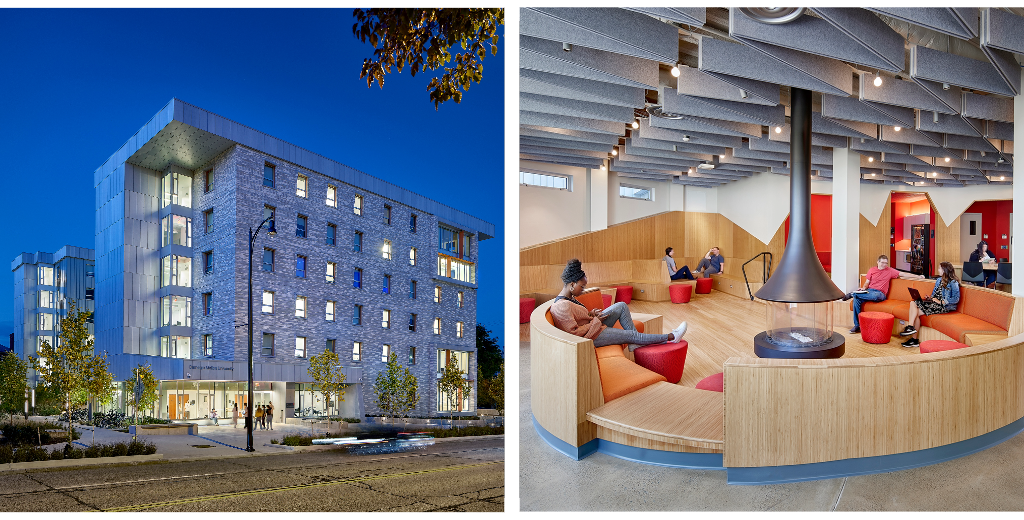
Fifth & Clyde Residence Hall and Neighborhood Commons
Architecture Firm: PWWG Architects
Project Team: Brent Houck, AIA, NCARB, LEED AP; Jennifer Szczesniak, RA, LEED AP BD+C, WELL AP; Cassandra Osterman, AIA, WELL AP; Jan Irvin, AIA, LEED AP; Adria Zawicki, AIA; Andrew Fortna
Client: Carnegie Mellon University
Contractor: Rycon Construction – General Contractor
Engineers: ME Engineers – MEP FP Engineers / Security / Technology / AV; Silman – MEP Engineer / Security / Technology / AV; Langan – Civil Engineer;
Photographer: Ed Massery
Affiliated Architect: LTL Architects – Design Architect
Landscape Architect: Merritt Chase – Landscape Architect
Consultants: evolveEA – LEED Consultant
A new six-story residence hall for 264 undergraduates, supporting holistic living, learning, and play. The project introduces a 5,000-square-foot community space for the Fifth Avenue neighborhood — referred to as the Fifth Avenue Neighborhood Commons — which includes rooms for students to practice music with a dedicated music studio and jam room, a wellness/dance room with spring-loaded flooring, study nooks, hammock area, and a multipurpose room.
Within the residential hall communities are skillfully created at multiple scales:
1) The Neighborhood – includes student rooms, central kitchens, and multipurpose spaces, plus the Commons and lush courtyard, for residents and the campus;
2) The Hallway Community – was sized to create smaller communities, drawn together at corners in common lounges and kitchens, with bay windows and expansive views;
3) The Hallway Community Expanded – Stairs connect corner social spaces to integrate communities from other floors; expanding the hallway community beyond the single floor.
JURY COMMENTS: “The three-dimensional massing strategy results in an elegant level of complexity to both the exterior as well as the interior. The spatial carving strategy generates clear results in how the building meets the ground, how it responds to the street, and how it becomes part of the fabric of the city. The material, tectonic, and textural resolution of the facade is impressive. Transparency at the entry and vertical circulation opens the building up to its surroundings and activates the edge of campus. Thoughtful attention to public spaces illustrates the design team’s passion for and understanding of the building’s function.”
LARGE: Honor Award

Eighth & Penn
Architecture Firm: PWWG Architects
Project Team: Brent Houck, AIA, NCARB, LEED AP; Joseph Filar, RA, LEED AP; Jennifer Szczesniak, A, LEED AP BD+C, WELL AP; Tonya Markiewicz; Sean Lange, RA, NCARB; Kevin Wagstaff; Adria Zawicki, AIA; Sarah Spanegel
Client: Trek Development Group with Q Development
Contractor: Mistick Construction – General Contractor
Engineers: Taylor Structural Engineers – Structural Engineer; Iams Consulting, LLC – MEP Engineer; Gateway Engineers – Civil Engineer
Photographer: Ed Massery
Landscape Architect: Moore Design Associates – Landscape Architect
Consultants: GeoMechanics, Inc. – Geotechnical Consulting; Clio Consulting – Historic Preservation Consulting
Eighth & Penn, in Pittsburgh’s downtown Cultural District, combines the rehabilitation of the historic McNally and Bonn buildings with new infill construction to complete the block. Reading as a series of buildings from the exterior, they function internally as a singular building. The new construction matches the scale of the historic sliver buildings along Penn Avenue and extends along Eighth, completing the urban street edge and block with a copper-clad addition. The separation of the forms creates a mid-block pedestrian passageway that creates a connection through the deep block. The passageway’s glass bridge is transformed with a light installation creating a destination space and a revitalized streetscape.
The mixed-use project is primarily residential with 140 apartments. Lobby access, a coffee shop, a corner restaurant, and a fitness studio fill out the storefronts and enliven the street edges along Penn Avenue and Eighth Street.
JURY COMMENTS: “The quality that this project delivers at such a large-scale is incredible. This innovative project successfully integrates existing structures on the historical registry with a series of careful additions that manage the overall scale of the intervention. Examples include, the way in which the building nimbly engages with the street life of the city while adding a pedestrian passageway between 7th and 8th street. The material choices of the varying facade treatments is an effective preservation strategy where old and new elements are in direct dialogue with one another. Lastly, the project has an elegant approach to reprogramming the sliver buildings that elegantly resolves the technical challenges of varying floor heights present in the building section.”
Social Impact in Design Award
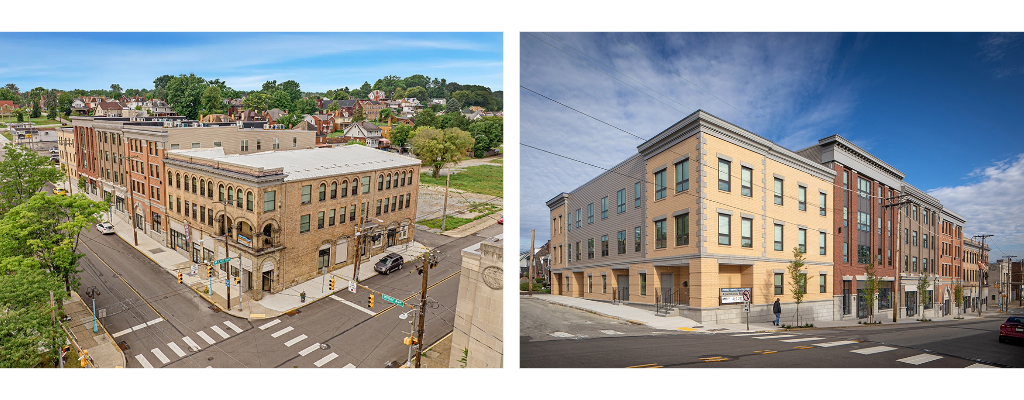
Clairton Inn Apartments
Architecture Firm: LGA Partners, LP
Project Team: Jonathan Glance, RA, AIA, NCARB; Jesse Gidley, RA, NCARB, CPHC; Gary Atcheson, RA; Alyssa Williams, CPHD; Roger Druschel; Bill Edmonds; Sandy Closson, CFM, NCIDQ, LEED AP; Mallory Marzolf
Client: Mon Valley Initiative – Clairton Inn, LP
Contractor: Mistick Construction, Shawn Schweiger – General Contractor
Engineers: Keystone Structural Solutions, Susan Grant – Structural Engineer; WNA Engineering, Greg Torchia – MEP Engineer; Whitney Bailey Cox & Magnani (WBCM), Randall Hughes – Civil Engineer
Photographer: Alexander Denmarsh
This design leverages a new affordable housing project to help reestablish a traditional main street in the heart of the rust-belt city of Clairton, PA. The historic Clairton Inn became the foundation for a new, contextual design that includes 49 new apartment units and amenity spaces over a new ground-floor retail. While the building plan is economical, the building elevation is a collection of façades designed to reference the scale and materiality of the surrounding context.
JURY COMMENTS: “It is clear that the design and development team sincerely engaged with the community very early in the design process. The approach is sensitive and carefully integrates the existing structure with the new construction to create a desirable streetscape. The façade treatments are successful in furthering the concept of fitting into the surrounding context. Clairton Inn Apartments most certainly creates a positive impact well beyond the building’s footprint.”
People’s Choice Award Winner

West Virginia University Medicine Children’s Hospital
Architecture Firm: IKM Architecture
Project Team: John Schrott, AIA, ACHA, EDAC; Matt Hansen, AIA, NCARB; Mindy Coblentz, AIA, LEED AP BD+C; Sam Smelko, AIA, LEED AP BD+C; Lisa Granger, NCIDQ, LEED ID+C, CHID, EDAC; Michele Kunkel, LEED AP, NCARB; Whitney Livsey, NCIDQ, Associate IIDA, LEED AP ID+C; Carrie DiFiore, LEED AP; Steve Stauffer; Greg Coni, AIA, CPHC; Angela Ranalli
Client: West Virginia University Medicine
Contractor: Yates Construction, Dan Meadows – Construction Manager, General Contractor, Cost Estimator
Engineers: CJL Engineering, Adam Hale – Mechanical and Electrical Engineer; Claitman Engineering Associates, Corey Bierer – Plumbing Engineer and Fire Protection; Atlantic Engineering Services; Gil Taylor – Structural Engineer; The Thrasher Group, Nicole Jones – Civil Engineer
Photographer: Adam Warner, IKM Architecture
Any Children’s Hospital serves the most vulnerable of our population: premature babies struggling to survive entry into the world, kids encumbered with challenging diseases that threaten to cut their lives short, and ordinary sons and daughters who require medical assistance to get back to being just kids. This Children’s Hospital prioritizes the wellbeing of traveling families, long-term patients, and stressed caregivers. In response to parent feedback, customizable LEDs were integrated into patient rooms to provide a sense of control. A neighborhood layout makes apparent the proximity of the nurse to reduce family stress. The top floor is dedicated to the Family Resource Center, where families, friends, and patients can “escape” to relax, enjoy a sit-down meal, or do some work. The design recognizes that caring for sick children can be emotionally draining. It is vital that both staff and families have spaces to recharge within the hospital.
Young Architects Studio Competition Award
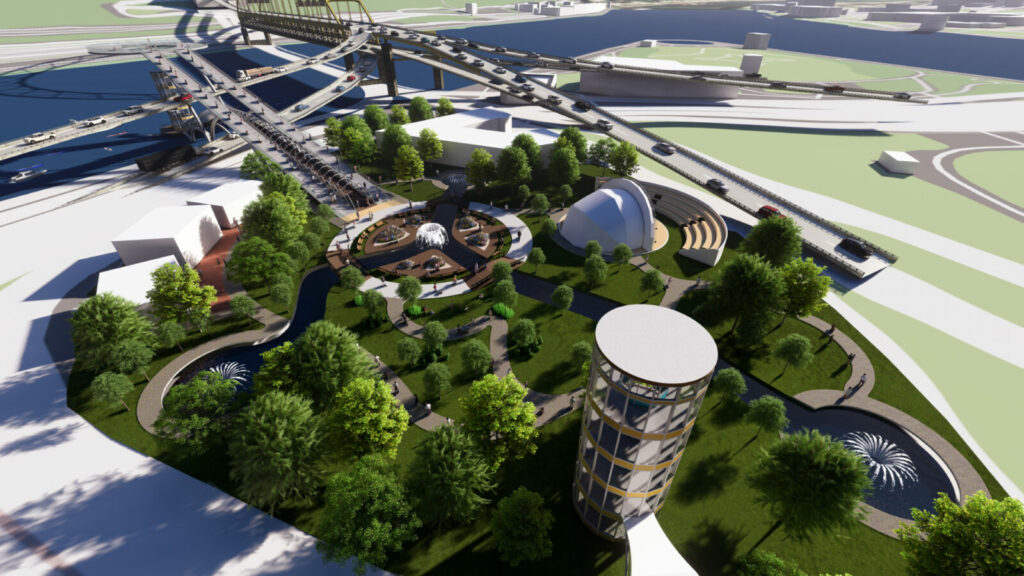
Confluence Chronicles: Navigating Pittsburgh’s Rivers
Architects: LGA Partners Team: Sanzinia Nevarez Cardenas; Samantha Clark; Nikita Williamson; Lindsey Reynolds; Cornelius Pace; Fabian Carrazana
The confluence of the Allegheny, Monongahela and Ohio rivers have always been a point of celebration and connection for the Pittsburgh region. The 3 rivers have connected Pittsburgh to the Northeast region of the country for centuries and continue to do as such. The goal of this project is to explore the connective thread between the past, present, and future of Pittsburgh’s riverscapes through the exploration of 4 distinctive sites we have coined Remembrance, Trade, Conservation & Unity Sites.
The jury found this entry particularly notable for its impressive degree of modeling, problem solving, and comprehensive approach to design solutions for all four sites. This entry managed to successfully address all three scales that are critical for the communication of place and for design proposals to solve—the small, medium, and large scale. The entry is so successful that the jury felt that each site can be broken out as standalone entries and still be maintained as a convincing design solution. The raised bridge proposed for the McKees Rocks site not only provides for a unique way to experience this site but also solves an accessibility issue inherent to this location. The constructive criticism provided during the discussions was that there were almost too many decisions per inch of board space and that perhaps some of the graphics could have been toned back into rudimentary diagrams or sketchy concepts to show more process. Overall, this was viewed as a compelling entry and notable for thoughts, effort, and vision set forth.

